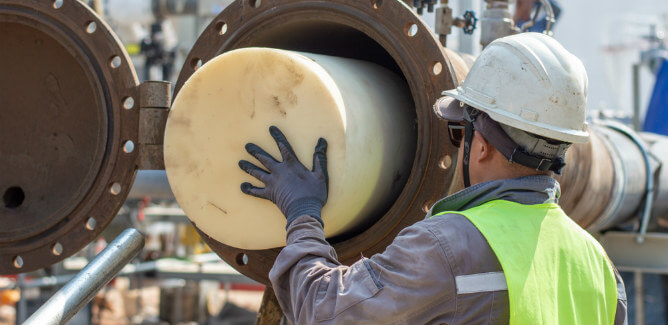
Pipeline Gauging and Proving for Optimal Pig Sizing
To generate and maintain maximum efficiency of oil and gas pipeline networks, operators need to ensure all aspects of the fluid transmission process is fully functional. During the construction of these oil and natural gas conduits, mechanical and structural defects may occur that diminish their functionality and overall productivity.
Before the commencement of full-scale gas transport, operators must test the efficiency of these pipelines while detecting and correcting structural flaws. The process by which pipeline engineering teams identify flaws and obstructions is called pipeline gauging.
In the case of newly constructed pipelines with no previous history of preconditioning, proving will enable operators to assess their suitability for full-scale natural gas transportation. This article will discuss why pipeline gauging/proving is important as well how a routine pipeline proving procedure is conducted.
How Are Pipelines Cleaned?
Once constructed, it becomes impractical to dismantle a pipeline into its components for cleaning. Typically, internal pipeline cleaning involves the use of a device called a pig. These devices will traverse predetermined lengths of a pipeline while scraping its interior.
The pigging procedure is highly effective in removing accumulated impurities from a flow line’s circulation. Although pigs can be used to clean pipelines, they can also be modified to conduct the gauging/proving of newly constructed natural gas channels.
Types of Pipeline Pigs
Subject to the type of pipeline process required, pipe pigs can be built to serve various functions. Pipeline pigs can be categorized into normal or conventional pigs, and smart pigs.
Normal Pipeline Pigs
Conventional pipeline pigs are composed of foam or plastic polymers shaped to resemble bullets. These pig types assembled with a gauging plate and driven through a pipe conduit to either clean its inner walls or confirm the uniformity of its diameter.
Smart Pigs
Smart pigging devices carry onboard electronics that detect variations within the lumen. These technologically enabled devices collect and analyze data while traveling through the pipeline. The data generated during its travel can be used to predict and correct flow deficiencies.

What Is Pipeline Gauging?
Gauging pipelines refers to the process by which defects in the structure of a newly constructed pipeline are recognized. Gauging is done during pipeline commissioning to ensure that a uniform diameter is maintained along the length of each pipeline. This assessment process is achieved using a pipeline pig device which is fitted with a gauge plate.
When a pipeline gauging plate is attached to a pig, it is then referred to as a gauging pig. Depending on the size of the channel to undergo pipe gauging, the plate must correspond to its exact internal diameter to accurately carry out its function.
What Is a Gauge Plate
A gauge plate is a metallic ring that is custom-built to link with a pig device. After passing the gauge plate through a length of a pipeline, it is recovered and examined. Evidence of wear on the plate surface is indicative of obstruction along the lumen of the pipeline. When a defective area has been identified, measures can then be taken to correct flaws or remove obstructions.
In some cases, a gauging pig may be fitted with a transmitter or a magnet which can be used to easily track its progress along a gas flow channel. These add-ons can prove to be vital in locating and retrieving a pig stuck in a pipeline.
What Are Gauge Plates Made Of?
The first generation of gauge plates was made of steel. This had a significant disadvantage of easily damaging the internal walls of pipelines undergoing proving. More modern gauge plates are forged from aluminum which has less disruptive effect when passed through a natural gas conduit.
Further, the size and thickness of a gauge plate varies depending on operator requirements and the nature of the pipeline system
What Is Pipeline Proving?
Pipeline proving processes are carried out on new flow lines that have never undergone any pigging. A proving sequence is an initial run done with a soft pigging device made from plain foam or a polyurethane-coated material to assess pipeline integrity.
After its journey, a sizing pig for pipelines is monitored to detect obstructions or areas of narrowing. Also, pipeline proving pigs will conduct basic cleaning, helping to push solid and liquid impurities out of the pipe’s interior.
Why Is Pipe Proving Critical?
Pipe proving is essential in assessing how well a new pipeline will perform. Pipeline proving provides an accurate predictor of the long term performance of a pipeline and helps conduit operators decide on capacity optimizing structural alterations.
NiGen Has Solutions for Your Pipeline Maintenance
At NiGen, we are committed to providing our clients with the most efficient industrial solutions. We provide a wide range of services and industrial products that are targeted at maximizing process capacity and output.
Please contact us online today to learn more about our O&G maintenance services, or our line of on-site nitrogen generators, industrial air compressor rentals, and desiccant dryer rentals.
